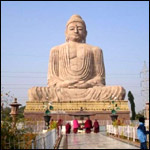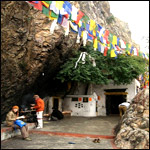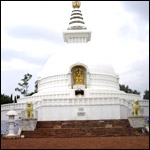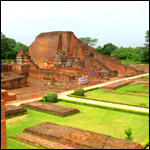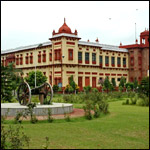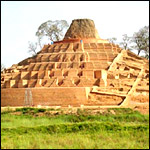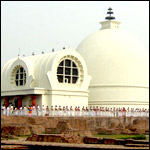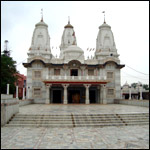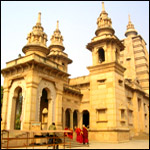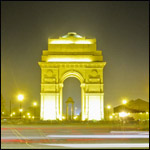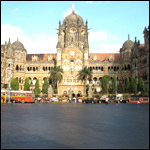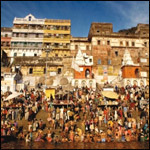|
|
|
|


|
 |
|
We offer you Manali hotel booking with return
tickets of Volvo AC bus sightseeing in Manali with car.
Now you can book your Hotel and Volvo AC bus with good Discount rates. |
Home »
Domestic Packages » Buddha circuit
Buddha circuit India
Several religions of the world have their
origins in India. Apart from Hinduism, Jainism, Buddhism and Sikhism
were born here. Buddhism has transcended India's boundaries and taken
root in East, South and South East Asia. Gautam Buddha, born a prince in
Lumbini set out towards India in search of the questions that troubled
him about life and suffering. His penance and meditation for years
showed him the path to 'nirvana'. After achieving enlightenment, he set
about preaching and sermonizing on the middle path to salvation, till he
left for his heavenly abode from Kushinagar.
On this guided tour, let's re-trace the steps of the Buddha from the place where he meditated, to where he attained enlightenment, to where he gave his first sermon, to where he donated his begging bowl before his death, and finally, to where he breathed his last.
On this guided tour, let's re-trace the steps of the Buddha from the place where he meditated, to where he attained enlightenment, to where he gave his first sermon, to where he donated his begging bowl before his death, and finally, to where he breathed his last.
Day 01: Gaya/Bodh Gaya
- Arrive in Gaya
- Drive to Bodh Gaya 13 km and check into hotel.
- Take a sightseeing tour of this holy seat of the Buddhist religion
A number of Buddhist nations like Thailand, Japan and Burma have set up monasteries and meditation centres in Bodh Gaya. Some of these include: the Indosan Nipponji temple, the Thai monastery, the Tibetan Karma Temple and Namgyal Monastery, and others by the Chinese, Burmese, Bhutanese, Vietnamese, Tamang, Daijokyo and Nepali Buddhist communities.
During October and March, monks from Dharamsala descend to Bodh Gaya. The Dalai Lama pays a visit here too during December and January.
The Mahabodhi temple is a World Heritage site, built adjacent to the site of enlightenment in the 6th century AD. The temple was attacked and plundered by Muslim invaders in the 11th century and re-built several times.
Return to hotel for overnight stay.
Day 02: Bodh Gaya - Dungeshwari Caves - Gaya
- After breakfast, proceed to Dungeshwari cave temples, 13 km.
- Here Buddha spent years of penance before attaining 'nirvana' or enlightenment.
- After lunch, return to Gaya to visit the Brahmajuni Hill, believed to be the site of Buddha's fire sermon. There is a cave and a temple on the hill top.
- Return to hotel for night stay.
Day 03: Bodh Gaya - Rajgir
- After breakfast, depart for Rajgir, 70 km, 2 hrs by road.
- Arrive in Rajgir and check into hotel.
Return to hotel for night stay.
Day 04: Rajgir - Nalanda
- After breakfast, proceed to Nalanda, 12 km.
After the walk around the ruins, visit the Xuan Zang Memorial Hall, a Chinese pagoda built by Chinese Buddhists. Return to Rajgir hotel for night stay.
Day 05: Rajgir - Patna
- After breakfast, proceed to Patna by road, 80 km.
- Arrive in Patna and check into hotel.
After lunch, take a local sightseeing tour of Patna. This would include: Golghar (built as a granary), Gandhi Museum, Patna Museum, Har Mandir Takht, Qila House or Jalan Museum with some really rare relics like Napolean's bed and Marie Antoinette's porcelain; and the ruins of Pataliputra.
Return to hotel for night stay.
Day 06: Patna - Vaishali - Kesariya
- After an early breakfast, depart for Vaishali, 44 km
Day 07: Patna - Kushinagar - Gorakhpur
After breakfast, depart for Kushinagar, 220 km by
road. Or else, you can take the train to Gorakhpur and drive 55 km from
there to this historic town.
Arrive in Gorakhpur and check into hotel.
Buddha breathed his last here, leaving a message for all mankind to find their salvation. Several monuments built by devotees from across the world have built monuments on this holy site along the Buddha Marg. These include: Vietnam's Linh Son Buddhists temple, meditation centre and gardens, the Burmese Mahasukhamdadacham Thargyi Pagoda, the Mahaparinirvan Temple with a tranquil and reclining Buddha and the Matahkuar temple, the Japanese - Sri Lanka temple and the Wat Thai temple. The Ramabhar Stupa, or the Mukutbandhan Stupa is the site of the cremation of Buddha.
Return to Gorakhpur for overnight stay
Arrive in Gorakhpur and check into hotel.
Buddha breathed his last here, leaving a message for all mankind to find their salvation. Several monuments built by devotees from across the world have built monuments on this holy site along the Buddha Marg. These include: Vietnam's Linh Son Buddhists temple, meditation centre and gardens, the Burmese Mahasukhamdadacham Thargyi Pagoda, the Mahaparinirvan Temple with a tranquil and reclining Buddha and the Matahkuar temple, the Japanese - Sri Lanka temple and the Wat Thai temple. The Ramabhar Stupa, or the Mukutbandhan Stupa is the site of the cremation of Buddha.
Return to Gorakhpur for overnight stay
Day 08: Gorakhpur - Sarnath
- Depart in time for train to Varanasi which is 5 ½ hrs from Gorakhpur
- Arrive in Varanasi and check into hotel.
- Take a short break before heading to Sarnath, 10 km.
Day 09: Varanasi - Delhi/Mumbai/Onward
Destination
After breakfast, take a tour of this holiest of
cities for the Hindus. The River Ganga is the lifeline of the city, and
all spiritual and religious activities are performed along its bank
Take a cruise along the river between the Dasaswamedh Ghat and Harishchandra Ghat and visit the temples. Participate in or observe the "Ganga aarti" in the evening, a spiritually uplifting experience in which the holy river is paid homage. Take the evening flight out to Delhi or your preferred destination.
Tour Ends.
Take a cruise along the river between the Dasaswamedh Ghat and Harishchandra Ghat and visit the temples. Participate in or observe the "Ganga aarti" in the evening, a spiritually uplifting experience in which the holy river is paid homage. Take the evening flight out to Delhi or your preferred destination.
Tour Ends.
|

